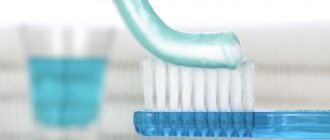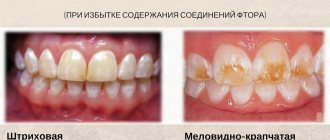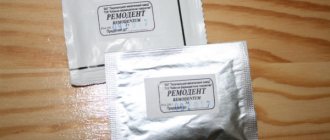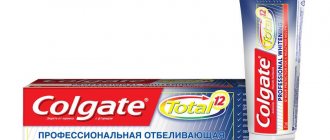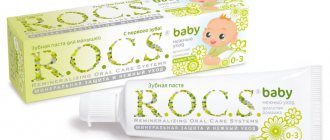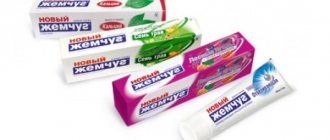Fluorine is an extremely important chemical element for the human body. First of all, it is necessary for the health of bones and teeth, and it is also responsible for strengthening the immune system and even removes heavy metals. The average daily intake of this element is 2 – 3 mg. It is found most in nuts, fish and seafood, green and black tea, beef liver, as well as cereals - rice, buckwheat, oatmeal. But the problem is that a person can consume only 0.8 mg of this trace element with food. How can we make up for what is missing? It would seem that the answer is very simple - ordinary drinking water. But don’t rush to rejoice, because water comes in different forms.
Fluorine
Fluorine (translated from Greek as destruction) is a chemical element related to halogens, a stable component of natural waters.
Its content in the earth's crust is high - within 0.095% by weight. As an impurity, fluorine is found in groundwater and is part of various minerals. Its concentration in sea water is 1.2-1.4 mg/l. The difference in fluorine concentration throughout the year is insignificant: fluctuations usually occur no more than twice a year. The waters of surface sources have a fairly low fluorine content - from 0.3 to 0.4 mg/l.
The reason for the high fluorine content in such waters is either the contact of the water with soils saturated with fluorine compounds, or the consequences of the discharge of industrial fluoride-containing wastewater. The maximum fluorine concentrations, in amounts from 5 to 27 or more mg/l, are found in mineral and artesian waters that come into contact with fluorine-containing water-bearing rocks.
Gel with calendula “Weleda” (Germany)
Gel of delicate consistency containing extract from calendula flowers, mint oil, fennel oil, esculin. The components will not harm the child, even if he decides to eat the paste.
The gel paste has an attractive taste and a light menthol smell, and does not tingle the tongue. No foam is formed during cleaning. Leaves a wonderful feeling of freshness. Effectively removes plaque.
Since the gel does not contain calcium, it is recommended to alternate it with pastes, for example, containing calcium glycerophosphate.
Price – 300 rubles for 50 ml.
Why is fluoride dangerous in water?
An adult's need for fluoride is 2-3 mg/day. This element enters the body with air, food, water and toothpastes. Fluorides dissolved in water, which supplies the body with 2/3 of the daily dose of fluoride, are most effectively absorbed. Thus, the concentration of fluoride in water is of decisive importance. Drinking water with a fluoride content of 0.2 mg/l is the main source of its penetration into the body.
Fluoride is one of the most important elements for human health. At the same time, the rate of its consumption is extremely close to the dose that can have a toxic effect. The amount of fluoride entering the body must be strictly within the existing limits, guaranteeing benefits and safety. The slightest deviation from the norm is fraught with the occurrence of a number of diseases related to metabolic disorders in bone tissue. This, first of all, affects the teeth: with an excess of fluoride, fluorosis develops, and with a deficiency, caries develops.
At the same time, the systematic use of water with an acceptable fluoride content reduces the level of diseases inherent in odontogenic infections (kidney diseases, cardiovascular pathologies, rheumatism and others).
"PRESIDENT Unique". Italian
Preservatives, allergens, parabens, sodium lauryl sulfate, dyes and, of course, fluoride are absent in this case. The natural plant-based formula gently enhances the oral cavity's natural defenses.
Calcium and xylitol thoroughly clean the enamel. Soothing and antibacterial effects are guaranteed by bioextracts of echinacea, sage, and chamomile. Anethole and eucalyptus are selected in ideal proportions to create a sensation of delicate, fresh, long-lasting taste.
Recommended:
- as a prevention of caries, inflammatory processes in the gums;
- with a lack of calcium in the body;
- to strengthen gums, increase the shine of enamel;
- for accurate and effective plaque removal;
- to reduce sensitivity.
It is advisable to apply two or three times a day. The estimated cost of 100 ml packaging is 190 rubles.
Maximum permissible concentration of fluorine in water
The permissible fluorine content in drinking water (depending on climate) is 0.5-1 mg/l. At higher temperatures, the fluoride concentration should be lower, since the volume of water consumed under these conditions increases. According to Russian SanPin 2.1.4.1074-01, the maximum permissible fluorine content in water should not exceed 1.5 mg/l.
Compared to other countries, this standard is too high and can have a detrimental effect on the human body. Fluoride has no characteristic color, smell or taste, so it is impossible to determine its amount in water yourself. To accurately determine the concentration of fluoride, it is necessary to conduct a water examination in laboratory conditions.
“ROCS – PRO Baby” (Russia) – children’s room
It can be used for little ones. A very soft base is used to make the paste, which, while gently cleaning, does not damage the fragile enamel of baby teeth. All ingredients are only of natural origin .
The absence of fragrances does not force the child to try the paste. No foam is formed during cleaning. After use, the teeth remain feeling well clean.
Price – 210 rubles.
To summarize, it must be said that some will remain faithful to pastes with fluoride, not wanting to change anything, while others will think about it and reconsider their attitude towards the described subject. Each person must draw their own conclusions based on extensive information.
If you find an error, please select a piece of text and press Ctrl+Enter.
Tags: fluoride-free toothpaste
Did you like the article? stay tuned
Previous article
Toothpaste from Thailand: types, features and reviews
Next article
Toothpaste “Crest” – description of varieties
Methods for purifying water from fluoride
There are several common methods for purifying water from fluoride compounds.
Reverse osmosis method
The principle of the method is to force water through a thin membrane, the pore diameter of which corresponds to the size of the atoms. Thanks to these pores, only water molecules pass through the membrane and other impurities in the form of viruses, bacteria, heavy metals, and organic molecules responsible for the unpleasant taste and smell of water are retained. The output is absolutely pure water, suitable even for the preparation of physiological fluids and injections. This purification technology is also used by bottled water manufacturers.
Filtration using organic bulk material
The method is based on the chemical interaction of organic bulk material with fluorine anion. Such materials are calcium phosphate, magnesium oxide and granular fine aluminum oxide.
Filtration using sorbent materials
The mechanism of this purification method lies in the ability of materials to sorption of fluorinated compounds from water. Such sorbents are ion exchange resins with a certain selectivity towards the fluorine anion. In addition, bone meal, modified zeolites, and activated carbons are used.
Electrocoagulation method
Water purification is carried out as a result of obtaining highly active aluminum hydroxyl in the process of electrolytic dissolution of anodes made of metallic aluminum, as well as its alloys. Due to low productivity, this method is not widely used.
Ultrafiltration
This method involves the separation of fluorine particles and water molecules. Given the larger size of fluoride molecules compared to water molecules, moving through a dense membrane, fluorides accumulate on the surface, and water molecules pass through the filter. This technology allows you to remove about 90% of fluorides.
Method for purifying water from fluoride using ultraviolet light
Water with excess fluoride content is irradiated with ultraviolet rays of a specific wavelength, or bactericidal wavelength. The range of this length is 200-400 nm. The main advantage of ultraviolet disinfection is the ability to disinfect water without changing its physical and chemical properties, as well as its high environmental friendliness.
"SPLAT Junior" - children's room
Recommended for children under four years of age . Includes xylitol and calcium, which, in combination with enzymes, increase the degree of protection of the mucous membrane. Particularly useful for children prone to frequent stomatitis .
Aloe Vera gel reduces discomfort when the first teeth appear. The creamy vanilla taste encourages children to try the paste. It's completely safe.
The declared non-existent component calcis is unpleasantly surprising. Unfortunately, the manufacturer does not provide any explanations, and anything unclear seems dangerous.
The price of a tube is 179 rubles.
Dangerous and beneficial fluoride
Fluorine is a common chemical element that is colorless, tasteless and odorless.
It is difficult to detect without special research, but its effect on the body can be seen even with the naked eye.
No other element has such a narrow concentration range, exceeding or decreasing which would affect health.
Even a slight deviation from the consumption norm can cause diseases associated with metabolic processes in bone tissue.
In humans, fluoride imbalance first affects the condition of the teeth.
Fluoride content in drinking water
If there is not enough of it, caries develops, if it is in excess, fluorosis appears.
Fluoride enters the body mainly through water. Food and fluoride toothpastes, unless ingested, have no serious health effects. In particular, toothpastes have only a local effect on tooth enamel.
The main supplier of fluoride is water.
The norm of its content in drinking water is in the range from 0.5 to 1 mg/l. Moreover, under conditions when more water is consumed (summer, hot period), the rate of this element in water should be reduced, since a person in the heat drinks more liquids than usual.
In our country, SanPiN 2.1.4.1074-01 defines the permissible concentration as 1.5 mg/l, but recent studies claim that this concentration is quite high, which can ultimately cause harm to health.
In natural waters in Russia, the fluorine content ranges from 0.01 to 11 mg/l. Increased concentrations are observed in the Tver, Tambov and Moscow regions.
Western Siberia and the Urals, as well as regions where aluminum is mined, are also characterized by an excess of fluoride in natural surface water.
There is also a danger that the fluorine content in surface waters, where it is determined by state laboratories for public utilities, may be reduced, but water in the same place, but taken not from surface sources, but from an artesian well, may contain an excess fluorine
To know for sure exactly how much fluoride enters your body every day, you need to ask the utility service that serves your home whether water is fluoridated (for regions with low fluoride content) or water purified (for regions with high levels of this element). For owners of country houses who take water from a well, the best solution would be to contact an independent laboratory to conduct a full chemical analysis.
If the percentage of fluorine content is increased, then it is necessary to filter it.
The best solution in this case is a reverse osmosis filter, which removes all impurities, including fluoride. You may subsequently need to artificially fluoridate the water purified in this way or include appropriate foods and additives in the diet, or use special toothpastes.
There are filters that do not remove fluoride from water, while purifying it of other impurities.
Our company has extensive experience in purifying water from chemical impurities. We will be happy to conduct a chemical analysis of your water and select the right set of filters that will provide the desired result and help maintain the health of your family.
Another creation of the SPLAT company – SPLAT-“Maximum”
The product is considered one of the achievements of modern dentistry. It is designed to quickly solve the following problems:
- protecting damaged and problematic areas of enamel from caries;
- providing a feeling of freshness in the oral cavity;
- plaque elimination;
- preventing the spread of harmful microbes;
- healing sore gums.
Nowadays toothpastes from Thailand are very popular. Find out what their advantages are!
Our article contains photos with all stages of caries.
Here: https://www.vash-dentist.ru/krasota-i-uxod/zubnyie-pastyi/rocs-vidyi-opisanie-tsenyi-i-otzyivyi.html - you will find reviews about Rox toothpaste for children.
These effects are achieved through the use of only natural ingredients. Nanohydroxyapatite is used to strengthen damaged areas of enamel. Removing stains from wine, tobacco, tea, coffee, dissolving plaque - the task of papain and polydon. Timon and zinc are intended to have an anti-inflammatory effect. But SLS and fluorine are not used.
Gentle cleansing is not accompanied by bleeding gums. After the cleaning procedure, a rather pleasant taste remains in the mouth, slightly reminiscent of eucalyptus oil. The paste will appeal to those who love the formation of foam while caring for their teeth.
An unpleasant surprise may be a slight tingling sensation in the mouth at the end of the process. And this seems to be the only drawback. And to the listed advantages we should add a low price - 115 rubles per 100 ml tube.
Excess fluoride in water
Review of the characteristics of water with a high fluorine content, determination of impurity standards, harmful effects on humans and household appliances
- Impurity standards
- Types of fluoridated water
- Harm from water with high fluoride content
- Summary
Fluorine is a light yellow gas, distinguished by its toxic properties and extremely pungent odor.
At the same time, fluorine is an important microelement necessary for the formation of bones and teeth.
This substance cannot be detected organoleptically (by taste and appearance) - fluorine does not affect the taste and smell in any way, and also does not change the appearance of water.
Level of fluoride impurities in water
Fluoride-containing substances are almost always added to tap water. But there are cases when the natural concentration in water exceeds permissible standards. In this situation, the amount of this microelement is artificially reduced.
The maximum permissible concentration of fluoride in water was established in 1994 by decision of an expert committee of the World Health Organization.
This rate is now 0.5-1 milligrams per liter and depends on the climate.
In equatorial countries with the hottest climates, where people need to drink more water, this figure is 0.5 milligrams per liter. As you move towards colder areas, the maximum permissible concentration in water increases.
In the coldest countries, where drinking water consumption is low, the concentration of fluoride should be the highest - 1 milligram per liter. In the United States, the fluoride standard in water ranges from 0.7 to 1.5 milligrams per liter.
The maximum permissible concentration in the world is set at 1.5 milligrams per liter.
Types of fluoridated water
Water containing fluoride is classified according to the method of fluoridation.
There are three such methods in total.
- Sodium fluoride (chemical formula – NaF). This substance was the first to be used to enrich water with fluorine.
It is this that is now considered the basis on which calculations are made regarding the content standards in water. Sodium fluoride is used in white crystals or powder form. It is the most expensive of all fluorine-containing substances, but very convenient to use. Sodium fluoride is most often used in small public utilities.
- Fluorosilicic acid (chemical formula H2SiF6).
This is an inexpensive liquid substance that is formed during the production of phosphate fertilizers. It is used in concentrations approximately equal to 23-25 percent. The only drawback is the expensive transportation of this substance, which is complicated by a large amount of water.
- Sodium fluorosilicate (Na2SiF6). Inexpensive powder or small, barely visible crystals. When used in mass quantities, it is the most popular substance, since it is much easier to transport than acid.
All three substances are highly soluble, safe to use and relatively inexpensive.
For comparison, natural concentrations of this substance are very high.
In groundwater the amount of fluoride can reach 67 milligrams per liter, in sea waters - 1.2 - 1.4 milligrams per liter. In surface waters this number is very small - only 0.1 milligrams per liter. Fluoride is also found in food products, such as fish and tea.
"SPLAT Juicy Set" (Russia)
It is designed for use by both small children and adults. Intensively strengthens enamel due to the content of an easily digestible form of calcium - hydroxyapatite. Enzymes also contained in the paste help increase the immunity of the mucous membrane and prevent the occurrence of stomatitis.
Three tubes in a set cost 250 rubles.
Data on fluoride content in drinking water in Russian regions
This is especially noticeable in children, who may ingest large quantities of fluoride toothpaste.
- A large amount of fluoride causes general exhaustion of the body , weakness and lethargy, because fluoride in large quantities has toxic properties.
The risk of myasthenia gravis (neuromuscular disease, muscle weakness) increases.
- The most toxic effect is on the liver . Accumulating there, it gradually destroys liver tissue.
- Fluoride, by interfering with hormone metabolism , can also affect the thyroid gland. Due to the gradual accumulation of fluoride in the body, the risk of thyroid disease .
- There is a version about the existence of a connection between Down syndrome and water fluoridation.
This is explained by the fact that some brain enzymes are extremely sensitive to the use of this trace element. The occurrence of Alzheimer's disease is partly attributed to the use of the same fluoride.
Harm to communication networks
Fluorine isotopes lead to the destruction of communications associated with pumps and plumbing. But this negative impact is usually not considered, because the occurrence of isotopes in natural conditions is practically unrealistic.
No harmful effects of fluoridated water on household appliances have been detected.
Modern scientists believe that the positive properties of fluoride and its protective abilities for teeth are somewhat embellished.
This is an extremely toxic substance; it was previously used as a poison for insects. It tends to gradually accumulate in the body, making it quite problematic to remove.
The amount of fluorine used should not exceed the maximum permissible concentrations.
Excess is much worse for health than its deficiency.
Everyone cares about dental health
Today in many countries people are wondering which fluoride-free toothpaste is the most effective and gentle on the tooth enamel of children and adults. After studying the ratings provided above, you can choose the most suitable remedy for yourself and your household. This will make it possible to avoid a number of dental problems in the future. And all because some gum diseases associated with oral hygiene are prevented by fluoride-free toothpaste. Ukraine (like other countries) can also use the list for itself, especially since many drugs are available on the shelves of local pharmacies and stores.
Fluoride in water: benefits and harms
The effect of fluoride on the body
Fluorine is an element that is found everywhere: in air, water, soil, and also in the bones of a living organism. Back in 1931, it was discovered that excess fluoride in water contributes to dental disease. Then it was decided to purify the water from fluoride, but another problem arose - the lack of fluoride began to cause dental caries. Scientists have looked into this issue and found that the fluoride content in drinking water is less than 0.5 mg per liter, which is too low, which contributes to the development of caries, especially in those areas where fluoride is insignificant.
A sufficient amount is a fluorine content of 1 to 1.5 mg/l. But there are areas where there is a lot of this fluorine both in water and in the air, especially in places where aluminum is mined.
Aluminum smelters release fluoride into the air, polluting the environment.
The difference between the benefits and harms of fluoride is so small that most researchers oppose water fluoridation.
On the other hand, fluoride supporters argue that it is thanks to fluoride that adults and children get rid of tooth decay. In fact, both are true, so it would be wise to stick to the middle ground.
Scientists came to the conclusion that 10 years ago, water fluoridation made sense, since there was little fluoride and only drinking water contained this element, so people really needed it.
Today the picture has changed. A developed network of industrial enterprises has greatly increased the content of this element in both air, water, and soil.
There are areas where literally everything is poisoned with fluoride, however, there are places where there is not enough of it.
Fluoride in drinking water
The fluoride content in drinking water in Russia, depending on the region, can range from 0.01 to 11 mg per liter. Thus, a large amount of it was discovered in the Moscow, Tambov, Tver regions, in western Siberia, in the Urals and in regions where aluminum mining is intensified.
Also, the fluoride content in one region can vary significantly. For example, increased fluoride levels in the Moscow region are observed in the Odintsovo district, Kolomenskoye, Zhukovsky, Ramenskoye and Zelenograd. However, in other areas it may be much less than normal.
It is important to know that there is much more fluorine in groundwater than in surface water. Therefore, if you live in an area where there is little fluoride, but drink water from an artesian well, you risk oversaturating your body with this element.
An excess of fluoride leads to the development of many diseases.
Fluorine is a dangerous element. To avoid many problems, you should treat it with caution. First, check what region you live in and what kind of water you drink. This is especially important for people who like to drink bottled water. It is necessary to carefully study the label of such water, since it may contain much more fluoride than in tap water.
The daily fluoride intake for an adult is no more than 2-3 mg.
Typically, 2/3 of the daily dose of fluoride is supplied with water. Therefore, you need to be very careful when drinking water.
Harm of fluoride
It is impossible to determine the presence of fluoride by sensation, since it has no taste, no smell, no color. Its presence can only be determined in the laboratory. To do this, you need to either do a water test or find out the data from the utility service.
Excess fluoride causes many diseases. First of all, this is the damage of teeth by fluoride, which is called fluorosis.
It causes changes in the color and shape of teeth, the direction of their growth.
Fluorosis has several stages and can appear in the form of pretty streaks and stains on the teeth.
First, individual lesions appear, then brown spots and enamel erosions appear, and the enamel seems to melt. As the disease progresses, a complete absence of enamel can even be observed on the teeth. The last stage is tooth decay. Such dental lesions are often observed in regions with fluoride content in water exceeding 5 mg/l.
Unfortunately, such teeth cannot be restored. As a result, the entire body suffers.
For the first time, the terrible truth about fluoride was revealed to the world by American nutritionist Paul Chappius Bragg. He wrote that “...fluorine is one of the most poisonous substances known to mankind.” He argued that "...selling this poison is big business for the aluminum smelters and nuclear industry."
Fluoride was first added to toothpaste in the 40s in the USA.
The program on mineralization of teeth with fluoride was written in the USSR in the 60s.
Due to the increasing incidence of fluorosis and damage to internal organs, many European countries have abandoned toothpastes containing fluoride. 14 Nobel laureates have become ardent opponents of water fluoridation.
In the United States, 40% of children suffer from fluorosis, but despite this, only 38 out of 50 states have abandoned fluoride.
Excess fluoride salts accumulate over the years in bones and tissues, causing osteochondrosis and sarcoma (cancer), and harming the digestive system. Leads to coarsening of the joints and their immobility. A person has difficulty moving, may experience chronic fatigue, muscle weakness, and cannot regain strength after rest. Fluoride is also a neurotoxin and can cause Alzheimer's disease.
And often people don't even realize that all these problems are related to fluoride.
The human body tries to protect itself by excreting fluoride in the urine, but does not always cope with its excess. Increased doses of fluoride pull magnesium from the body and calcium from the bones.
Therefore, it leads to their calcification, and calcium settles in the muscles, lungs and kidneys.
Fluoride in products
Food contains a lot of fluoride in tea, fish and seafood. Most contain fluoride ranging from 0.2 to 0.3 mg. Fish can contain from 5 to 15 mg. It is also found in whole milk.
Krill meat contains very large and dangerous amounts of fluoride. 1 kg of raw mass contains 2 g of this element, and boiled mass contains approximately 750 mg.
For comparison, the permissible fluoride content in 1 liter of wine is 5 mg. The fluorine content in tea depends on the ability of the tea to absorb fluoride from the soil by the tea bush itself, on fertilizers, and on the time of collection. The more brewed tea is infused, the more its fluoride content increases.
It all depends on where and under what conditions the tea was grown and what fertilizers it was treated with. Very often, tea is treated with fluoride-containing pesticides, which it absorbs. Accordingly, by brewing such tea, we will obtain a fairly high fluoride content.
Fluoride for teeth
The use of fluoride toothpaste, if the paste is not swallowed, can harm or help only the teeth, but not the entire body as a whole.
You only need to use a small pea. It is not advisable to use fluoride-containing pastes for pregnant women and preschool children.
If fluorine in water exceeds one, it is not recommended to use fluoride-containing pastes.
Adults do not need fluoride, nor do adolescents over the age of 16, since they already have formed tooth enamel.
Fluoride should be used with caution in children under 3-4 years of age. Prevention and restoration of enamel can be carried out without fluoride. To do this, you need to brush your teeth properly, use modern products that contain elements that make up tooth enamel - calcium and phosphorus.
List of toothpastes without fluoride
In Russian stores, toothpastes with fluoride and calcium are mostly found on sale.
But if you look hard enough, you can find toothpastes without fluoride. Thus, the domestic toothpaste deserves attention, which has received recognition for the fact that it contains no harmful substances.
Another good toothpaste from the same manufacturer does not contain fluoride - this is “SPLAT-MAXIMUM”, “SPLAT JUICY SET”, children’s toothpaste “SPLAT JUNIOR”.
The line of toothpastes without fluoride is also complemented by toothpastes “ROCS FOR ADULTS”, “ROCS – PRO BABY” for children, “ASEPTA SENSITIVE” from the Nevskaya Cosmetics company.
From the line of imported pastes, one can note such pastes as “PRESIDENT BABY” gel and “PRESIDENT UNIQUE” paste made in Italy, “WELEDA” - calendula gel made in Germany.
But most of these pastes have some disadvantages - the presence of SLS, parabens and other chemicals, which are also not good for the body.
Considering all these pros and cons, I chose for myself organic toothpastes without fluoride, sold in the iHerb online store.
They do not contain harmful substances and are completely natural. To enhance the effect, I also use organic herbal rinses. I especially liked a teeth rinse like PerioBrite from the manufacturer Nature's Answer. It contains coenzyme Q10, chlorophyll, folic acid and 25 plant extracts. It contains no SLS, artificial sweeteners, parabens, preservatives, alcohol or antiseptics that kill beneficial oral microflora.
I tried it with mint and cinnamon. I liked both. Using these organic toothpastes and rinses for two years has significantly improved my oral health, so I decided to buy them on an ongoing basis, and I recommend it to you too!
Did you like the article? Share with friends via social networks. To always keep abreast of new articles on the Women's World website, subscribe to the News Feed. To search for other articles, use the site map.
Fluoride: benefits and harms
Fluoride (lat. fluorum) is a necessary trace element for the development of bones and teeth. Fluorine is a microelement found in all organisms.
In animals and humans, fluoride is present in bone tissue and, especially, in dentin and tooth enamel.
This element is unevenly distributed in the human body: the concentration in teeth is 246 - 560 mg/kg, in bones - 200 - 490 mg/kg, and in muscles does not exceed 2 - 3 mg/kg.
Fluorine plays an important role in bone formation and normalization of phosphorus-calcium metabolism. Basically, in childhood, during the formation and growth of permanent teeth, fluoride is deposited in the tooth enamel.
The main source of fluoride is drinking water (it comes from food products 4–6 times less).
The microelement content in water should be approximately 0.7 - 1 mg/l.
Products containing fluoride:
For cooking, you can use fluoridated salt - an effective tool in the prevention of caries. Remember that too much salt is harmful to the body. Everything should be in moderation.
Where else is fluoride found:
- fish (most of all in mackerel, cod and catfish - up to 5 - 10 mcg/g);
- animal meat (lamb, veal);
- seafood.
The World Health Organization suggests the optimal daily dose of fluoride for an adult is 1.5 – 4.0 mg/day.
Too much fluoride is more dangerous than too little fluoride.
Lack of fluoride in the body
We need fluoride in microdoses.
But this does not detract from its importance for the body. Without fluoride, iron is poorly absorbed in the human body, so there is a high risk of developing diseases such as iron deficiency anemia and caries.
A low fluoride content destroys tooth enamel by leaching fluoride from fluorapatite. The main manifestations of fluoride deficiency are dental caries and osteoporosis. Insufficient intake of fluoride into the body is associated with a decrease in its level in drinking water.
There are two approaches to preventing caries: systemic and local. Systemic is the consumption of drinking water and products enriched with fluoride within acceptable limits. Local - use of fluoridated toothpastes, gels, varnishes, etc. Be sure to consult your dentist before using them!
But fluoride is by no means a panacea for caries, but only a means of prevention. It is also important to eat right and visit a dentist.
Excess fluoride in the body
When drinking water with a high fluoride content, symptoms appear such as pathological changes in bones and teeth (the appearance of chalky stains on teeth, fragility of enamel), dental fluorosis, nausea, vomiting, damage to the central nervous system, a drop in blood pressure, metabolic disorders, blood clotting disorders, bone fluorosis.
An excess of fluoride in drinking water is typical for some northern regions of Russia and for areas with aluminum production enterprises.
How to avoid the dangerous effects of fluoride on the body?
Check with your utility company to see if the water entering your apartment is treated with fluoride.
If yes, then:
- DO NOT cook food in an aluminum pan - fluorine forms a dangerous compound with aluminum;
- DO NOT use tap water to cook food for children;
- This water is dangerous for pregnant women to drink;
- Use NOT tap water to make tea, as tea already contains a lot of fluoride.
How to choose toothpaste
When choosing therapeutic and prophylactic pastes, you need to pay attention to their purpose and composition. For example, these funds may include:
- For the prevention of caries: calcium components.
- For teeth whitening: carbamide (urea), hydrogen peroxide, powerful abrasives (more gentle based on silicon, rougher based on calcium carbonate or chalk).
- For increased tooth sensitivity: components of potassium compounds, hydroxyapatite, aminofluoride, strontium.
- For increased bleeding and gum inflammation: antiseptics (triclosan, chlorhexidine), plant extracts (green tea, chamomile, calendula, oak bark, etc.), plant oils, enzymes (lactoferrin, lysozyme, lactoperoxidase), vitamins (A, B, C , E).
- To refresh the oral cavity, soothe the mucous membranes, prevent inflammation in the mouth: essential oils or natural supplements. It is important to clarify the abrasiveness (cleaning ability) of this product. In case of increased tooth sensitivity, pastes with an abrasiveness of no more than 25 units are usually used.
The best abrasive (with gentle plaque removal) is silicon dioxide. The size of the cleaning particles is important. The smaller they are, the more gentle the cleaning will be.
If whitening is necessary and there are no problems with the enamel, you can use products with an abrasiveness of 90 c.u. or higher.
Fluoridated water - benefit or harm
There is currently no substantiated evidence that fluoridated water strengthens teeth and bones.
But, nevertheless, many experts say that water fluoridation is a kind of therapy that has no analogues in the history of medicine.
But it is also known that if you use fluoride for a long time, this can lead to sad consequences - the occurrence of osteoporosis, osteomyelitis, Down syndrome, dental disease and changes, and cancer.
To perform water fluoridation, the following products are mainly used: fluorsalicylic acid and sodium fluoride. And it must be said that these are substances obtained as a result of industrial production, and they are never found in living nature.
Moreover, these substances are toxic, quite strongly, so they are included in insecticides and rat poison. But the natural fluoride salt itself - calcium fluoride - is non-toxic, but it is not used for water treatment by water fluoridation.
At the moment, quite a few countries in the world have made water fluoridation mandatory in urban water supply systems.
But if desired, you can get rid of the presence of fluorine in water by installing special devices - filter systems, distillers, etc. Therefore, if you want to protect your family from drinking fluoridated water, you need to either install additional water purification filters or buy clean water.
What are the dangers of fluoridated water and is its use dangerous? Discussions on this topic are becoming increasingly fierce. On the one hand, the presence of fluoride is beneficial for teeth, but on the other hand, its excess amount will generally cause harm to the body. How to avoid causing even more harm to yourself?
Benefits of fluoridated water
The ability of fluorides to protect teeth from decay and prevent cavities was discovered as a result of experiments back in 1940.
It was then discovered that if a cotton swab soaked in a fluoride solution is applied to a diseased tooth, the tooth can then be cured. Fluorides prevent tooth decay because they destroy bacteria that produce harmful enzymes.
Moreover, they enrich tooth enamel with minerals. But most scientists agree that only local exposure prevents tooth decay.
It was also found that the prevalence of dental caries in adults and children who drank fluoridated water and those who drank regular water was the same.
Studies conducted in 2001-2002 showed that if water fluoridation was stopped, tooth decay and the occurrence of diseases did not increase.
The dangers of fluoridated water
And although there are positive examples of drinking fluoridated water, there are also the opposite, where negative effects can occur. And many studies conducted indicate this. Here are just a few examples.
Drinking fluoridated water at a standard concentration of fluoride (one part per million) increases the adsorption of aluminum into brain tissue (experiment was conducted on rats), which can lead to changes in brain tissue similar to those that occur in Alzheimer's disease.
“New pearls with calcium” from Nevskaya Cosmetics
The cheapness of the product (30 rubles) is explained by the absence of additional additives, as well as enzymes and xylitol. The only active component is calcium citrate. Its task is to mineralize teeth, although not sufficiently.
Here you can both read reviews about Sensodyne toothpaste and leave your own.
In this article you will learn about ways to prevent cervical caries.
Here: https://www.vash-dentist.ru/detskaya-stomatologia/d-zubi/karies-dz/kak-i-zachem-provoditsya-serebrenie-molochnyih.html - it is told which is better - fluoridation or silvering of baby teeth .
Above were presented toothpastes for adults. Next, we will look at fluoride-free oral protection products for babies.


